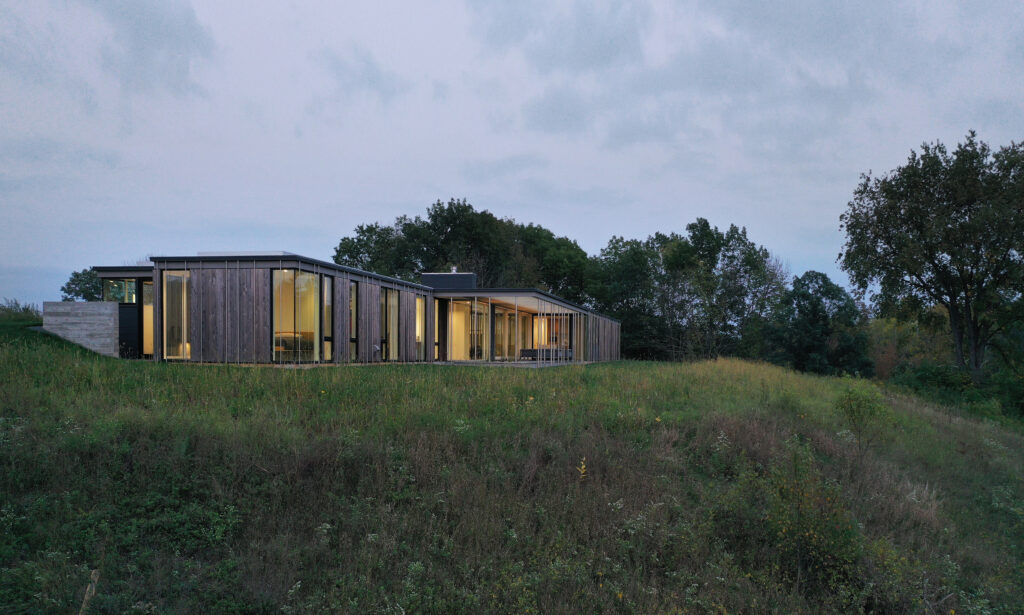
The Kettle Moraine House, named after the eponymous glacial landscape in central Wisconsin, is a private residence quietly nestled in its natural setting of Campbellsport, Wisconsin. The House sits at the far end of an elevated plateau of recently restored native prairie, its low-slung linear volume overlooking an expansive wetland and small creek beyond. From the nearby county road, the house appears as a faint line in the distance, seemingly floating above the grasses and quietly complementing the Kettle Moraine’s stretching horizon. The main objective for the design of the family home was to allow the building―the only man-made structure within the prairie fields except for the picturesque ruins of an old barn that was intentionally preserved as a reminder of the land’s agricultural past―to virtually merge with its surroundings, minimizing its visual impact on the bucolic scenery while reinforcing the connection between inside and outside, between architecture and nature.
The driveway winds through the prairie and past the ruins of an old barn, a graceful memento of the land’s former agricultural use, before aligning with a long, board-formed concrete wall that extends into the site’s gentle topography and carefully choreographs the final approach toward the house. The concrete wall acts as an anchor that physically ties the house to the surrounding land and leads visitors to the entry and retains the rising terrain along its back side. This allows the building to partially embed itself in the ground, minimizing its visible profile.


The glass entry door, on axis with the long concrete wall and positioned to frame a small, visually arresting grove of birches in the distance, leads into a narrow vestibule with a wooden screen wall that separates it from the main living hall. Exposed wood beams articulate a coffered ceiling and extend to the outside space. The design was further guided by passive solar strategies as a trellis over the patio in tandem with a deep, carefully sized overhang shelter the generously glazed central space of the house. The two shield the interior from excessive solar exposure during the hot summer months and carefully regulate the sunlight entering the house year-round. In the winter, the features let the winter sun radiate deep into the house. The grey concrete floor collects and stores heat as thermal mass for release during colder hours. The exterior walls, which are wrapped in a rainscreen façade of reclaimed barn wood, are insulated with expanding foam made from agricultural byproducts; low-E argon-filled double and triple-pane glazing throughout contribute to a high-performing building envelope. At night, the narrow window band radiates its warm light into the distance, subtly evoking the enigmatic clerestory glow of the dairy barns that once dotted the region. The concrete perimeter wall continues eight feet beyond the northwest corner of the house, where it defines the boundaries of a small walled-in garden for meditation and privacy.

The exterior material palette’s mix of exposed concrete, weathered wood, and glass are deliberately restrained in order to echo the muted hues of the region’s vanishing barns and silos. The knotty boards of the precisely detailed rain-screen facade add a degree of rusticity to the overall rigor and formal discipline of the house; they are complemented by a series of randomly spaced vertical stainless-steel rods, their thin, silver lines a subtle nod at the small birch grove beyond. The rods were held off by one inch, allowing them to cast shadows on the building envelope and adding visual depth to the overall composition; along the patio, they transform into slender columns supporting the roof perimeter and overhead trellis. Expanding foam insulation, derived from agricultural byproducts, allows for R-values of 36 and 55 in walls and roof, respectively. The enclosure system is complemented by high-performance glazing and poly-ash siding and trim, a cradle-to-cradle product with superior resistance to rot and decay.
The project included the restoration of more than 50 acres of abandoned farm fields into native prairie, rehabilitating the land’s original biodiversity and turning it into a new sanctuary for wildlife and birds.



Leave a Reply